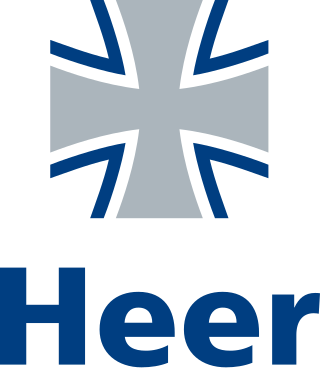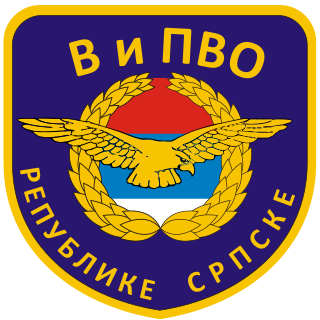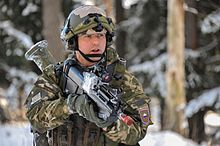
The Czech Armed Forces, also known as the Czech Army, is the military service responsible for the defence of the Czech Republic as part of the Armed Forces of the Czech Republic alongside the Military Office of the President of the Republic and the Castle Guard. The army consists of the General Staff, the Land Forces, the Air Force and support units.
After the creation of the Statute of the Kingdom of the Netherlands, the Royal Netherlands Army was entrusted with the defence of Suriname, while the defence of the Netherlands Antilles was the responsibility of the Royal Netherlands Navy. The army set up a separate Netherlands Armed Forces in Suriname. Upon independence in 1975, this force was turned into the Surinamese Armed Forces. On February 25, 1980, a group of 15 non-commissioned officers and one junior officer, under the leadership of sergeant major Dési Bouterse, staged a coup d'état and overthrew the Government. Subsequently, the SKM was rebranded as the National Army.

The Albanian Armed Forces are the military of Albania and were formed after the declaration of independence in 1912. Today, it consists of the General Staff, the Albanian Land Force, Albanian Air Force and the Albanian Naval Force.

The Serbian Armed Forces is the military of Serbia.

The German Army is the land component of the armed forces of Germany. The present-day German Army was founded in 1955 as part of the newly formed West German Bundeswehr together with the Marine and the Luftwaffe. As of January 2022, the German Army had a strength of 62,766 soldiers.

The Yugoslav People's Army, also called the Yugoslav National Army, was the military of the Socialist Federal Republic of Yugoslavia and its antecedents from 1945 to 1992.

The Croatian Army is the largest and most significant component of the Croatian Armed Forces (CAF).

The Ten-Day War, or the Slovenian War of Independence, was a brief armed conflict that followed Slovenia's declaration of independence from Yugoslavia on 25 June 1991. It was fought between the Slovenian Territorial Defence together with Slovene Police and the Yugoslav People's Army. It lasted from 27 June 1991 until 7 July 1991, when the Brioni Accords were signed.

The Pandur II is an improved modular all-wheel-drive version of the Pandur 6x6 APC wheeled armoured vehicle. It was developed as a private venture by the Austrian company Steyr-Daimler-Puch Spezialfahrzeuge. Steyr-Daimler-Puch Spezialfahrzeuge is part of General Dynamics European Land Systems (GDELS), which is also the parent company of MOWAG of Switzerland and Santa Bárbara Sistemas of Spain.

The Pandur is an APC developed and produced by the Austrian company Steyr-Daimler-Puch Spezialfahrzeuge (SSF). It was developed during the 1980s as a private venture. In 2003, General Dynamics took over Steyr-Daimler-Puch which is now part of General Dynamics European Land Systems, which is also the parent company of MOWAG, Santa Bárbara Sistemas and GD ELS – Germany.

The Republika Srpska Air Force was the air force of Republika Srpska and was used primarily during the Bosnian war. In 2005, it was integrated into the Armed Forces of Bosnia and Herzegovina. SFOR still plays a large role in Bosnia and Herzegovina, which consists of the Federation of Bosnia and Herzegovina and Republika Srpska. Under the leadership of one president, the ministry of defense of both entities merged into one single ministry of defense with one chief of joint staff commanding both Air Forces. In 2004 there was again a restructuring of the armed forces, bringing the number of Air Force personnel down to 4,000. Next to the command, the 1st Regiment V i PVO consists out of a platoon, a radar battalion, artillery rocket ADF battalion, AF logistics battalion and aviation assets, a Fighter Bomber Squadron and Mixed Helicopter Squadron. In 2006 the Air Force of Republika Srpska was disbanded.

Cerklje ob Krki is a settlement on the left bank of the Krka River in the Municipality of Brežice in eastern Slovenia. It is best known for the Cerklje ob Krki Airport north of the settlement. The area is part of the traditional region of Lower Carniola. It is now included in the Lower Sava Statistical Region.

Slovenian Air Force and Air Defence is a part of the Slovenian Armed Forces. It is an integral part of the command structure, not an independent branch.

Cerklje ob Krki Airport is the only military airport in Slovenia, and a civilian airport. The Cerklje ob Krki Air Base operates at it. The airport is in the midst of an enlargement and restructuring.
Jernej Molan Barracks, also known as the barracks at Cerklje ob Krki Krka, is a barracks of the Slovenian Armed Forces, which is located in Cerklje ob Krki, Slovenia.

The VBM – Freccia is a family of 8x8 armoured vehicles that was designed and manufactured for the Italian Army by IVECO for the hull, the engine and the suspension, and OTO Melara for the armament. The first variant to be developed was the IFV, the Freccia being equipped with a Hitfist turret, the same as the one installed on the Dardo IFV.

The Czech Land Forces are the land warfare forces of the Czech Republic. The Land Forces consisting of various types of arms and services complemented by air and special operations forces constitute the core of the Czech Armed Forces. Land Forces Command is located in Olomouc.
This article represents the structure of the Austrian Armed Forces since April 2019:

Enhanced Forward Presence (EFP) is a NATO-allied forward-deployed defense and deterrence military force in Northern, Central and Eastern Europe. This posture in Northern Europe through Estonia, Latvia, and Lithuania and in Central Europe through Poland, Slovakia and Hungary and in Eastern Europe through Romania and Bulgaria, is in place to protect and reassure the security of NATO's Northern, Central and Eastern European member states on NATO's eastern flank.





























